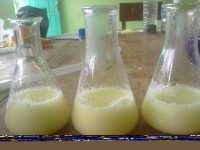Waste Cooking oil is a cooking oil that has been used repeatedly. This oil is to used household needs, generally can be reused for culinary concern, but when viewed from its chemical composition, waste cooking oil contains carcinogenic compounds, which occur during frying process (Anonymous, 2011a), so it is quite worrying when we reused for cooking oil to cooking again.



In this study on the use of ash from the skin,branch, twig kapook wood, wood that has been burned to ashes then soaked in water for about three days, it is intended that the existing potassium in ash and extracted can be used as a base for the manufacture of soap. After three days, it will formed alkaline solution decantation it, after it must measured pH in this research, we obtained the pH is 13-14, it is good enough for the saponification reaction

Cooking oil purified using activated carbon derived from coconut shell ashes that have been in the puree, mashed karboan in the mortal then filtered or sieved, activated carbon is used to purify used cooking oil by absorbing impurities in the used cooking oil so that it can be better when in use for the manufacture of soap

A total of 130 grams of cooking oil mixed with 30 grams of KOH solution obtained from the kapok wood burning ash while heated at a temperature of 60 ° C for 1 hour, stirring constantly, mixing aims to form a soap through a saponification reaction, then added water as much as 60 grams to enhance reaction.

Furthermore, to increase the cleaning power of soap and clean power added 5 grams STTP (sodium Tripoli Phosfat) and 5 grams of Texapon, this material serves to soap has made a pretty good power washing.

Soap which has been established then colored to give power to taste good aesthetic value and given fragrance to give fragrance to the soap.

The results have been successfully synthesized liquid soap, viscous and foam, then testing in a manner which is used to clean hands dirty because dirt in the form of dry ink and charcoal from the kitchen pot

Hands that have been polluted with ink and charcoal then given the soap from wood ash cottonwoods that had been made later in the rub on both hand, the results are directly soluble impurities in the soap and liquid soap to black.

Liquid black soap was then rinsed with clean water and a hand that has been given a dirt stains from the dried ink and charcoal pans had to be clean.






